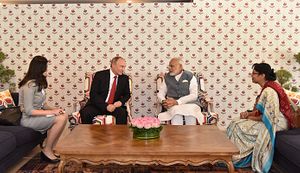The recent BRICS summit in Goa, India, came to an end on Sunday with a joint declaration that was as anodyne as such documents usually tend to be. Though India made it a point to focus on terrorism and managed to underscore “the need for close coordination on tracking sources of terrorist financing and target the hardware of terrorism, including weapons’ supplies, ammunition, equipment and training,” it could not convince China to change its stance on Jaish-e-Mohammad chief Masood Azhar. China had recently put a technical hold once again at the United Nations and prevented Azhar — who India believes was behind the Pathankot attack this year and the Parliament attack of 2001 — from being designated a global terrorist, despite Jaish being a UN-proscribed terror group.
Sino-Indian ties have been going downhill for the last few years and the future of the five-country BRICS grouping remains tentative at best because of this growing divergence. But it was the other bilateral relationship — India-Russia — that was the focus of the Goa summit. Where Sino-Indian bilateral engagement was perfunctory at best, the India-Russia relationship was given a big boost with New Delhi reaffirming ties with its longstanding strategic partner.
India’s ties with Russia have seen turbulence in recent weeks with Moscow deciding to conduct its first military exercises with Pakistan at a time when New Delhi was targeting Islamabad for its terror strike in Kashmir. Despite India’s opposition to Russia conducting these bilateral exercises with Pakistan, especially at a time when Indian troops were also participating in bilateral military exercises in Russia, Moscow went ahead, raising concerns in New Delhi about the future trajectory of Russian foreign policy. Moscow, for its part, has been obsessed with challenging the United States and saw a growing U.S.-India partnership as a threat. Moreover, at a time when U.S. ties with Pakistan are deteriorating, Moscow has agreed to sell Islamabad four Mi-35 attack helicopters and build a $2 billion natural gas pipeline there.
During the BRICS summit, India sought to re-engage Russia more substantively. Russia and India signed a multi-billion dollar deal for S-400 Triumf long-range air defense missile systems, an agreement on building Project 11356 frigates for the Indian Navy, and setting up a Russian-Indian joint venture to produce Kamov Ka-226T helicopters – worth an estimated $10.5 billion. India will be the second customer for the S-400 — called the SA-21 Growler by NATO — after China. The Russian and Indian leaders also took part in a ceremony laying the foundation for the third and fourth power units of India’s Kudankulam nuclear power plant. On the energy front, the two sides announced a deal valued at around $13 billion for Russian state-controlled oil giant PAO Rosneft and two others — Netherlands-based commodity trader Trafigura Group Pte. and Russian investment fund United Capital Partners — to take over India’s Essar Oil Ltd. And to allay Indian concerns, Russian officials made it clear that Moscow has not signed any contracts and has no plans for signing any military-related deals with Pakistan.
For an estimated $100 billion upgrade of its mostly Soviet-era military equipment, New Delhi has been looking largely at the West for cutting-edge technologies. Though there has been dissatisfaction in sections of the Indian military and policy-makers at the manner in which Moscow has handled its defense contracts in recent years, there is a recognition of the need to have strong ties with Russia as it has been one of the few states willing to share strategic technologies with India, including aircraft carriers and nuclear submarines.
The two states also reiterated their common opposition to terrorism. As Indian Prime Minister Narendra Modi underlined, “Russia’s clear stand on the need to combat terrorism mirrors our own. We deeply appreciate Russia’s understanding and support of our actions to fight cross-border terrorism that threatens our entire region. We both affirmed the need for zero tolerance in dealing with terrorists and their supporters.” But Russia failed to come to India’s support when it came to Pakistani-sponsored terror. China successfully persuaded Russia to its position.
Indian concerns on terrorism ended in abeyance in the declaration even as Moscow’s own concerns on Syria got reflected in the declaration, which called upon all parties involved in the Syrian conflict to work for a comprehensive and peaceful resolution of the conflict taking into account the legitimate aspirations of the people of Syria, through inclusive national dialogue and a Syrian-led political process. Russia’s kowtowing to China shouldn’t be surprising, but it managed to challenge India’s long-held conviction that Moscow would always come to the aid of New Delhi. Russia under President Vladimir Putin is determined to position itself as a major global player and is enhancing its ties with China to gain leverage in its ties with the West. Similarly, in South Asia, Russia wants to reposition itself if only to caution India of cozying up too far to Washington at its expense.
During his joint press conference with the Russian president, Prime Minister Narendra Modi said in Russian, “an old friend is better than two new ones.” This remark was aimed at both Russia, which has been giving a fresh look to its ties with Pakistan, as well as at those who have been questioning his commitment to India’s old partners like Russia. India and Russia tried to re-establish “the special and privileged nature” of their strategic partnership. But the limits of the partnership were as obvious as its promise.

































